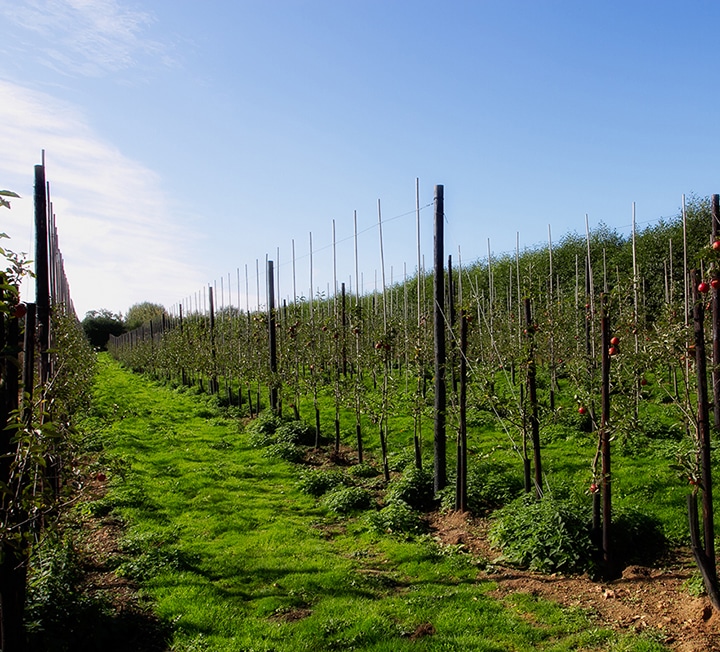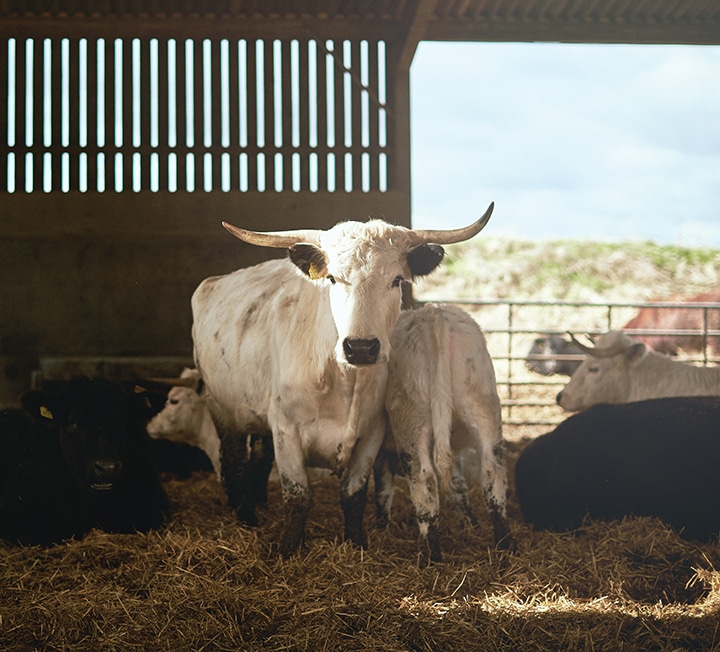Root and branch reform
In the hills of Andalucía, a pioneering foundation has been introducing farmers to the concept of ‘agroforestry’, a sustainable system of production in which arable crops and legumes are grown side by side with trees – a move away from the intensively-grown monocultures that do so much damage to precious agricultural land. Clare Finney pays a visit
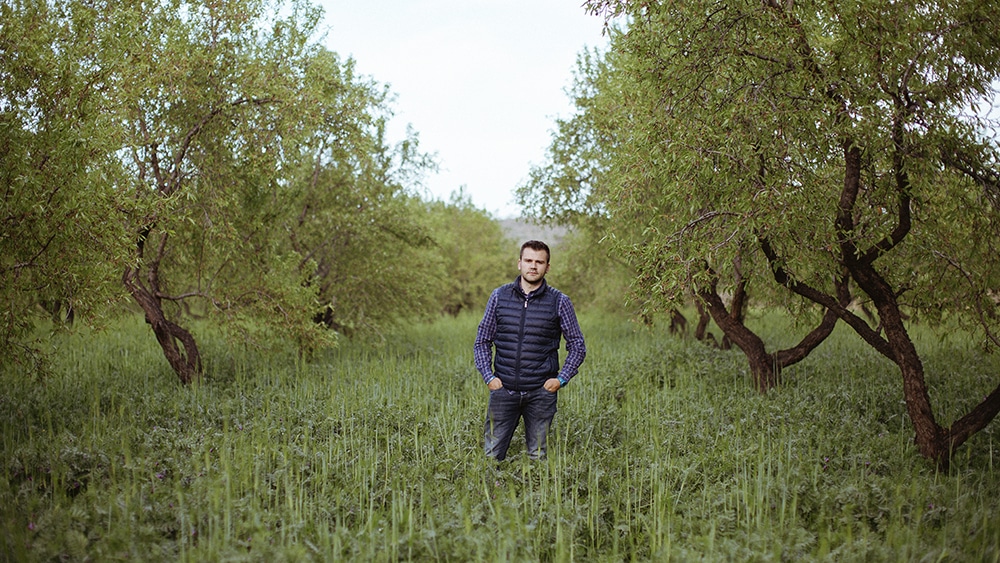

“FARMERS ARE BEGINNING TO REALISE THAT TILLING MIGHT BE THE REASON THEIR CROPS ARE STRUGGLING, NOT THE CURE”
Images: Joseph Fox
“To work with nature is art. It’s beautiful. Because nature is not lines – only curves,” says Frank Ohlenschlaeger, feelingly. We look out across the landscape – an El Greco of green and brown, enveloped in folds of grey mist – and back round at the caves we’re staying in, their shelves and cabinets built into nooks and crevices of undulating white walls. Frank’s company, Almendrehesa SL, is deeply involved in restoring these landscapes by reintegrating them with natural processes – a concept known as regenerative farming. The fruits (or, in fact, nuts) of his work can be found at Borough Market, thanks to Charles Tebbutt, whose Food & Forest stall sources almonds and walnuts from farms that use a form of sustainable agriculture called agroforestry.
“What Frank is doing here is fantastic,” says Charles. We’re in Andalucía, southern Spain, on the way to visit our first almond farm. Along the way, we pass field after field of windswept farmland and, tellingly, wind turbines, whirling away in the gusty sirocco winds. Working with the local AlVelAl initiative and Commonland – a global foundation which develops landscape restoration projects in areas vulnerable to erosion and climate change – Frank’s company has been instrumental in coordinating farmers, researchers, technicians and public bodies to drive forward one of Spain’s most ambitious regeneration schemes.
“He coordinates the different farmers who supply him, visits and advises interested farmers on how to farm more sustainably, and facilitates press visits like this that spread the word about landscape regeneration and agroforestry,” Charles explains. It’s these farmers who supply Food & Forest with those large, smooth-as-a-dime almonds that look and taste a million miles away from those you find in the supermarkets, most of which hail from California’s San Joaquin Valley.
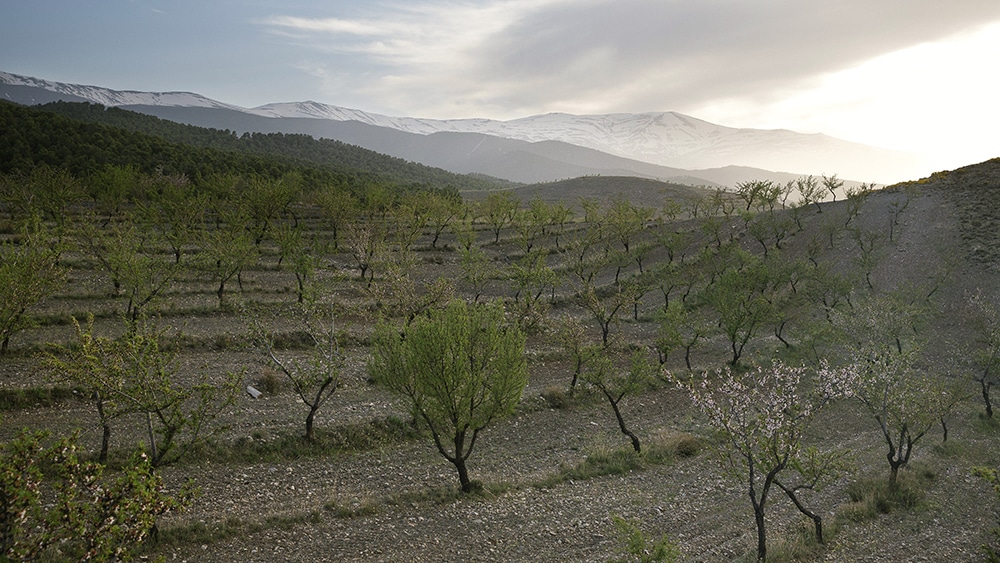
On Charles’s Borough Market stall you’ll find photos comparing their nut farms to the barren wastelands left behind by California’s intensive agriculture. “It’s a false economy,” says Charles of their methods, which see huge swathes of land exploited in the name of productivity at the expense of flora and fauna. In the short term this means more almonds; in the long term this leads to desertification and its consequences – plummeting crop yields and devastating water shortages. Initiatives like AlVelAl and Commonland are growing in influence in Andalucía because farmers are “seeing the consequences of intensive production and wanting advice on how to stop them”.
Factor climate change into the equation – in the past three years this region has had 150 litres of rainfall instead of the expected 300 to 400 litres – and it is little wonder farmers are struggling. “You can see it all the way from Madrid to Granada,” observes Frank. “There it is all monoculture, and the soil is really eroding.”
Frank is not from Andalucía. He is not even Spanish – hailing instead from Germany. But his facility with the culture, language and people of this region is peerless. “I know all the farmers I work with here. It is not anonymous – we have good relationships.”
The philosophy behind Commonland is the invention of “a common land”, he continues. Regenerating the landscape is not an end but rather a means of creating a sustainable economy. “We need to inspire people, particularly young people, to live and work in this area, not disappear to big towns or to other countries.” The youth unemployment rate in Andalucía, he explains, is one of the worst in the country, “so the landscape restoration project must not happen in isolation. It must include young people. They must see the benefits. We call it the return of inspiration. The second return is a social return: to create jobs for all the people in the area, and ensure the opportunities and profit is not concentrated in one company.”
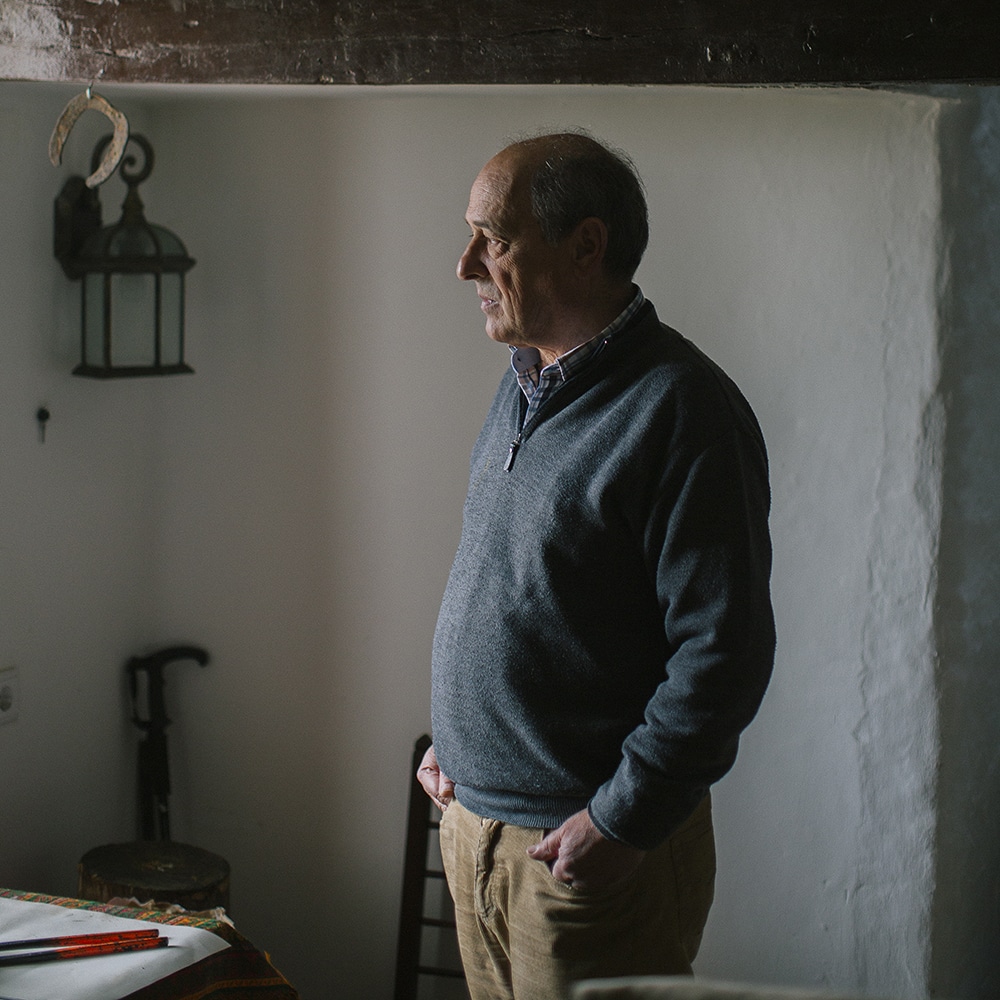
Miguel Angel Gómez Tenorio is a case in point. His is the first farm we visit: a family affair outside Granada, with almond trees coming softly into fruit, shedding their blossom. Where the land beneath the trees of a conventional almond farms would be brown and barren, his is verdant with cereals, herbs and legumes. “One of the reasons I like working with Frank and Miguel is that they are taking the benefits of their university education, then going out there and applying it to the real world – not sitting in their ivory towers,” says Charles, referring to the pair’s degrees in agroeconomics and agriculture respectively.
Standard almond agriculture dictates that fields be tilled, or ploughed very regularly, to direct all the soil’s goodness toward the almonds. Miguel takes a different tack: in September he plants his ground crop; come late spring, the crops are ploughed gently back into the soil. “The legumes are ‘nitrogen-fixing’ plants. Their nodules contain nitrogen-fixing bacteria that make nitrogen in the air available to the soil. It’s a miracle!” says Frank. The barley, meanwhile, supplies organic carbon. The result is what Miguel and Frank call “green manure”: plants which, while they grow, reduce erosion and run-off, then when ploughed into the soil provide nitrates, organic carbon, other nutrients and water.
Miguel is a farmer. But he is also a researcher and a professor at a nearby university, where he works during week days. One job informs the other: on the way around the farm we pass an experimental section where he is cultivating the almonds in different conditions and conducting long-term analysis of the results. One is green manure, one is traditional manure (sheep, cow and chicken faeces), one is bare, and one has a fast-acting type of compost.
“I want to analyse the quality of the fields over 20 years – not just the quality of the soil, but also the quality of the almonds,” he tells us. Initially most farmers come to Frank because their land is suffering, or because he pays a good rate, or both. But to be persuaded of the benefits and potential of agroforestry and sustainable agriculture, they need hard evidence – and that’s where people like Miguel come in. He is young, he is educated, but with his livelihood and that of his family bound up in the farm, he is also results-driven. “My interest in the project is 100 per cent.”
He takes out his phone and flicks to a photo of a stern-looking older man, his arms crossed and his legs planted in the same field we’re standing in. “This is my father. His philosophy is tillage. He’s not convinced by the idea of crop cover – he believes it competes with the almonds.” It’s a common problem in Andalucía – indeed in any region where farms are passed down through generations. The older, more traditional farmers believe tilling three or even four times a year is best practice, as it breaks up the dry soil and takes out the competition between ‘weeds’, as they see these ground plants, and the crop they want to cultivate. Farmers of the next generation, however – at least, those who still want to follow their parents into farming – are beginning to realise that tilling might be the reason their crops are struggling, not the cure for it. As a result, each farm we visit here is a patchwork of fields managed by the old guard, and those managed by their more pioneering daughters and sons.
“Many farmers don’t consider the financial costs of tilling, or its possible environmental impacts. Often they do it because their father did it, without really asking, ‘Is this good or bad?’” The problem with constant tilling, Frank continues, is that without the structure of organic matter there is nothing to hold the soil together and retain the rain water. It just runs away and as it goes, leaches the soil of nutrients and leaves it more susceptible to erosion by the region’s winds.
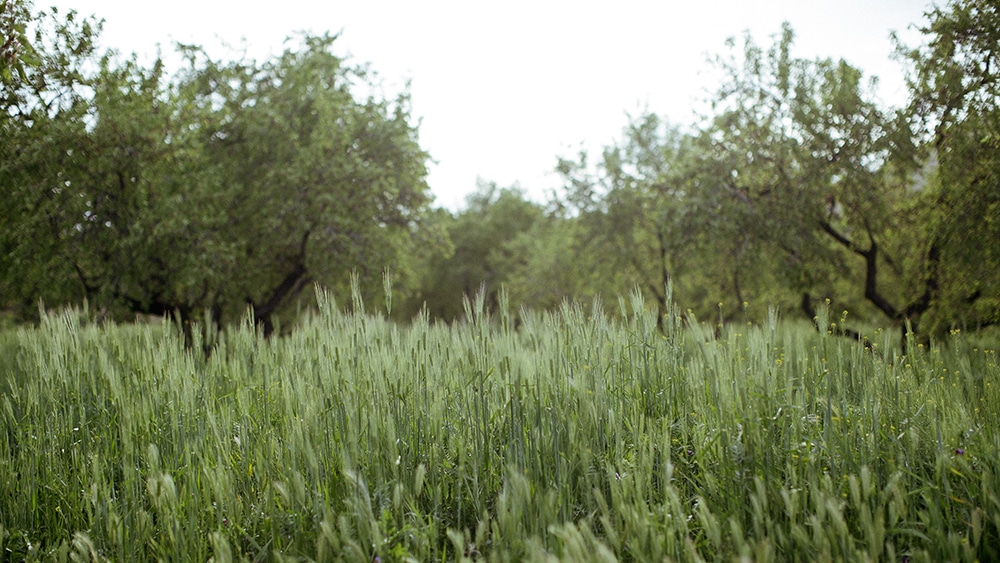
Miguel’s father is coming round to this perspective – in part persuaded, no doubt, by the lush greenery surrounding Miguel’s almond trees and, crucially, on the trees themselves. “I flooded these fields for just an hour last week,” Miguel says, pointing to an ancient Roman irrigation system that carries water to the village from the snow-capped Sierra Nevada mountains. The flood prompted a surge of greenery. By way of contrast, his father’s adjacent field of almond trees remains resolutely brown.
Many old-school farms have gone beyond the point where simply adding more artificial fertiliser can compensate for the levels of degradation. But to challenge such deep-rooted farming practices is “very difficult”, Frank says. There are farms you can point to as growing evidence of the benefits of agroforestry – Miguel’s is one – but there aren’t many, and few farmers have the time, interest or resources to explore alternative ways of scratching their living from the land.
It’s why Frank offers tempting prices; why his mind is constantly whirring as to how farmers can get the best out of sustainable agriculture, without compromising their income or their eligibility for EU subsidies. “The money is the first motivation to change. Later it is important that they see there are advantages to changing that go beyond money: that they see the fields improve, the crop improve in quantity and quality. I hope that, in time, when farmers have more knowledge of regenerative farming, it won’t just be the price that encourages them to continue.”
His work is beset with challenges. For a start, the EU rather bafflingly withholds its almond subsidy if a farmer also sells the crops grown between the nut trees. “You can plant what you want – barley, herbs, legumes – but you can’t sell them if you don’t want to lose your subsidies. It is stupid,” Frank says, irritably. He hopes this will change, and in the meantime has enlisted the help of a small processor of essential oils, who might be able to use the lavender and other herbs grown on the farm to make aromatics. Nor is that all Miguel’s lavender shrubs are good for.
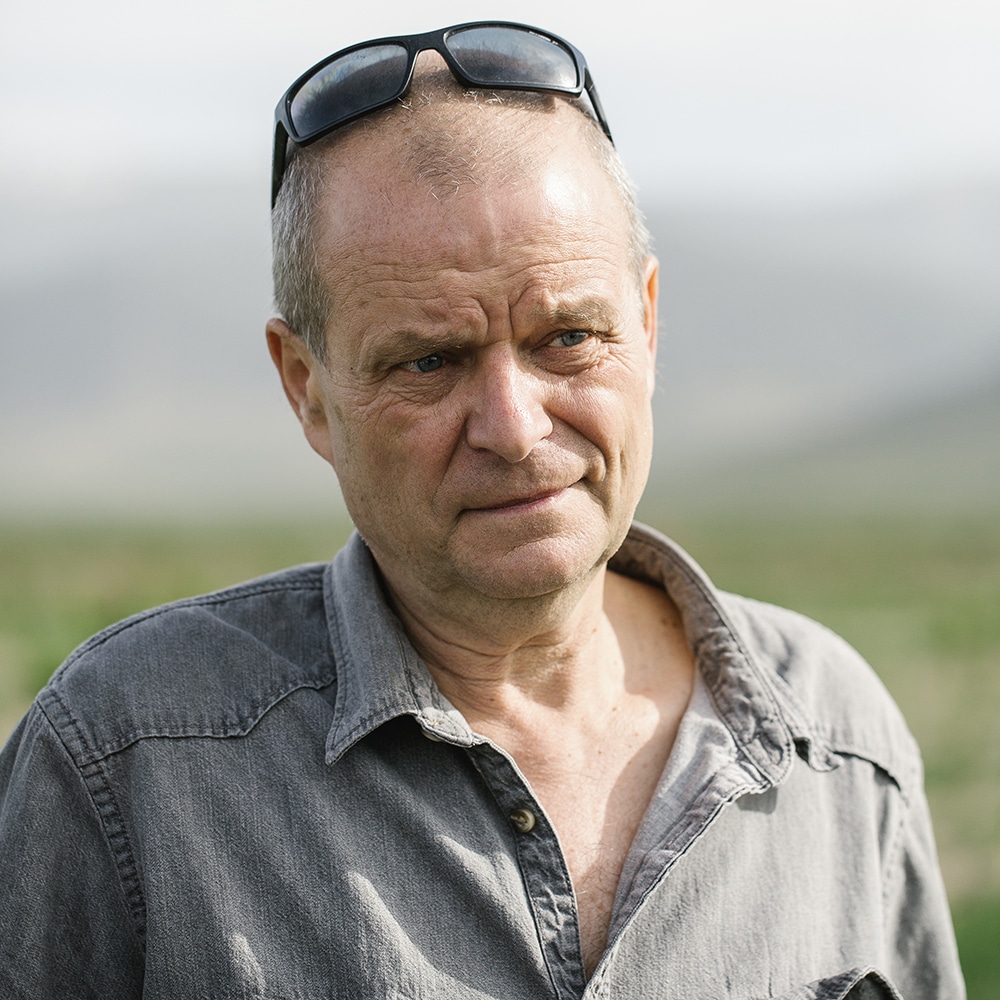
Following the lazy line of a bee from its feast in a lavender bud, I realise his farm is peppered with hives. “The beekeepers are happy because Miguel farms without pesticides, and we’re happy because the bees are pollinators,” Frank explains simply. “In the future I would like to sell almond honey.” But he needs more time, more money and crucially, more farmers. “The problem is most farmers think they don’t need bees, because new varieties of almond tree are self-pollinating. But you can still improve the harvest. We still need bees.”
To most of us, organic farming is something of a gold standard, implying harmony with the environment and healthier, more natural produce. To Frank, it’s a not a helpful categorisation. “The requirements for organic certification in Europe are the bare minimum. All it means is the producer has not used synthetic pesticides or fertilisers. You can still raze the ground four times a year. You can still use organic pesticides, which sounds okay until you realise how much more environmentally and financially effective it is to just encourage the natural predators that already exist.”
Similarly, the nitrates provided by the organic fertiliser will in fact stymie any nitrogen production from legumes. “Nature doesn’t fix nitrogen if it’s already there. It’s smarter than that.” There is such thing as bad organic farming, he continues, just as there is bad conventional farming. “Whereas for me, regenerative farming, ecological farming, is what very good organic farming should be.” It’s a sustainable system, it doesn’t depend on constant inputs. Of course, you need some sort of compost – green manure, sheep manure – but not frequent applications of organic fertiliser that’s been made elsewhere. “That shouldn’t be necessary. Farmers should be able to make their own compost, which is better-suited. Ecological farming is knowing the relationship between the climate, the plants, the soil and so on, respecting this relationship, and supporting it in your approach to farming.”
We move on, reluctantly: Miguel’s farm is an oasis. While the almonds have yet to ripen, the furry green buds smell full of promise. Our next stop, however, is what Charles describes as “textbook agroforestry”: a walnut farm that grazes indigenous sheep, with crop cover on the ground beneath the trees. It’s also an example of an EU agricultural subsidy breeding ingenuity, albeit inadvertently; the farmers were simply looking to get a forestry grant when they planted a field of walnut saplings a few years ago.
“A member of their family has a walnut farm in another part of Spain and gave them some,” explains Frank. It was only recently that they decided to harvest them and expand their collection to 20 acres, and “10, maybe 15 different varieties?” says farmer Rafael Ordínez (pictured top). The variations are too subtle to detect. Sampling a handful from his November harvest (“we sun-dry them for 15 to 30 days, outside. We’d love a solar powered dryer but” – he gives the ‘money’ shrug), I am hit by crunch after crunch of warm, creamy earthiness; a flavour which, unlike many walnuts, hovers tantalisingly on the line between bitter and sweet.
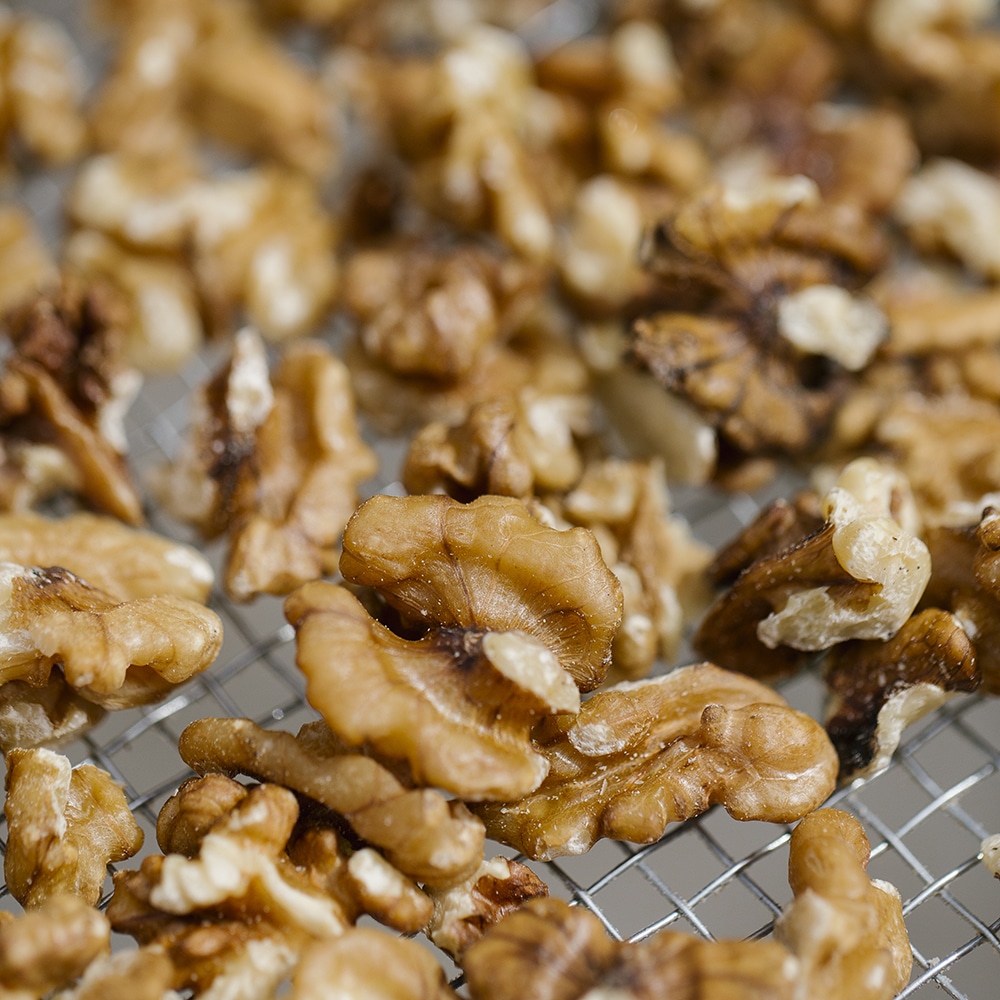
This is farming at its most simple, yet most effective. “The sheep do the work of a compost heap, except they do it in two days rather than six months,” explains Frank. The farmer tills just once a year, a policy implemented as a money-saving exercise, but continued once it became clear how much better the soil was as a result. Rafael Ordínez is not as young as Miguel. Nor does he have a degree in agriculture. “But he is university educated, he is interested, he is reading new research, he understands economy,” Frank explains.
Among the young people of Spain, and indeed elsewhere in Europe, the role of farmer has increasingly come to denote poor education – even small-mindedness. Redressing this perspective and repositioning farming as a professional career, worthy of respect and demanding knowledge and skills, is as fundamental to the Commonland and AlVelAl initiatives as wood pasture grazing. “We want to be proud of being farmers, and we want our sons and daughters to feel that as well.”
If their businesses are to have a chance of surviving into the next decade, these farmers need a younger generation: their understanding of marketing and trading, and their English. The absence of these skills among people of a certain age in Spain is, according to Frank, Franco’s legacy: “He was strongly isolationist. French and Spanish were the only languages he permitted.”
Are times changing? From the people we visit it’s hard for me to say, but I am heartened by the farmer who owns the caves in which we’re staying, overlooking Andalucía’s shifting landscape. Like many in this region, he supplements his living as a farmer with an additional income – in his case, a collection of beautifully converted caves. “In Spain we have young people who are very prepared; who are good and hardworking, who speak many languages,” he says passionately. “We have three members of our cooperative under 30,” says Frank. “Our biggest farmer is 27.”
They know about marketing, about the hard lines of packaging design and commerce, but they also care deeply about environment. Slowly – very slowly – they are bringing these skills back to the curving land from which they came.
